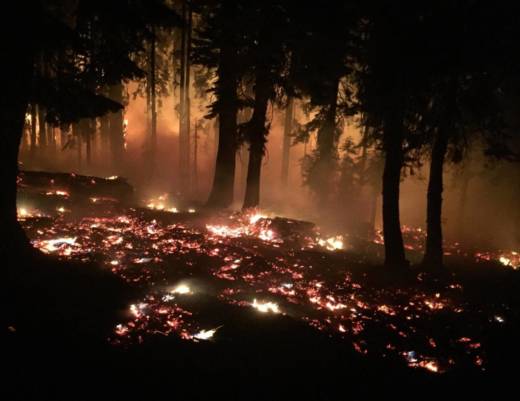Three years ago, the Happy Camp Complex burned 135,000 acres and actually rekindled the following summer.
The Eclipse Complex is 50 percent contained, and the U.S. Forest Service says the only way it will be fully contained is with significant help from Mother Nature.
"Honestly, the complete containment will probably be when we get a season-ending event, which is significant rain and significant snowfall," said Joshua Veal, a spokesman for the Klamath National Forest.
There are extensive areas of the burning timberland that the Forest Service does not send firefighters into because the terrain is so steep. Fire officials attempt to confine the blazes by trying to push them toward natural barriers and previously burned areas.
It's a practice that's becoming more common in the region. The frequency of major wildfire activity has increased in the last decade, according to Siskiyou County Supervisor Ray Haupt.
"This is becoming an every year or every other year event," Haupt said last week. Eight of the 12 communities in his district have been under different kinds of evacuation orders in recent weeks.
"It's a huge disruption to our normal commerce of agriculture and tourism. It pretty much destroys our recreation industry," Haupt said.
Smoke from the wildfires have led to extremely unhealthy air conditions for many of the county's communities for weeks.
"These folks have been in smoke all summer long," Veal said.
The wildfire smoke, which has also come from major blazes in Oregon, Washington, British Columbia and elsewhere in California, has prompted many local residents to leave for weeks at a time -- if they can afford to travel.
The official unemployment rate in Siskiyou County, which includes the towns of Mount Shasta, Weed and Yreka as well as dozens of tiny communities like those along the Klamath, currently stands at 6.7 percent, the state says. But Haupt says the rate in some towns in his district is between 40 percent and 60 percent.
While residents face adversity, the officials coordinating the battle against wildfires in the area face their own obstacles -- one of the biggest being a fight to get personnel and equipment in the midst of a bad fire season throughout the West and disastrous weather events in the Southeast.
"We have been in very fierce competition for resources," said Veal, adding that massive wildfires in Oregon and hurricanes in Texas and Florida have pulled away emergency workers.
A total of about 1,500 firefighters are currently working on the three big Siskiyou County blazes, according to federal officials -- about 500 each on the Eclipse, Salmon-August and Orleans fires.
"This issue with these megafires has been that there aren't enough firefighters in the world to be able to put some of these out," Haupt said. "The terrain is against you, (and) the weather is against you."
Firefighters got a break from the weather last week, with cooler, wetter conditions settling in and allowing them to work on tasks like retrieving gear and repairing damage done while building fire lines.
Officials recently lifted fire restrictions in Klamath National Forest, now allowing visitors to have campfires. But there are still a number of closures to recreation areas, including some along the Pacific Crest Trail.

